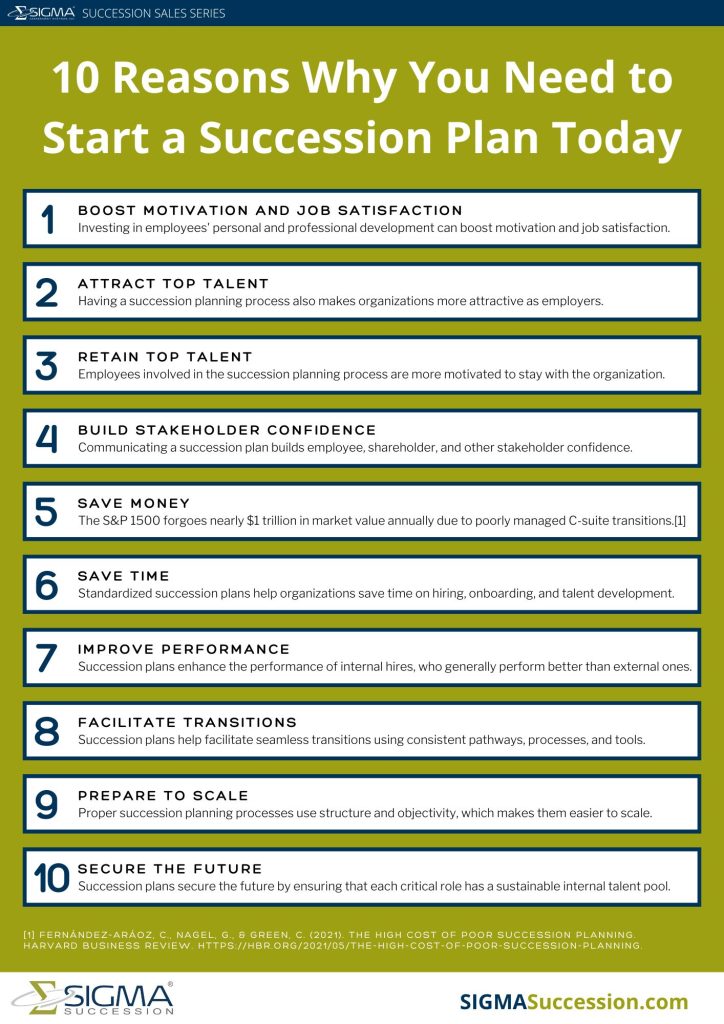Leadership Succession Planning
“The business changes. The technology changes. The team changes. The team members change. The problem isn’t change, per se, because change is going to happen; the problem, rather, is the inability to cope with change when it comes.”
– Kent Beck
Change is one of the only constants over time. In the context of the workplace, illness, retirement, and turnover are inevitable. Still, many organizations don’t devote sufficient attention or resources to preparing for the future.
One of the best ways to prepare for the future is by implementing a leadership succession planning process that will help to bridge the gap between an organization’s current talent bench and their future needs. SIGMA offers robust and customized succession planning services that can help you get this process started.
What is Leadership Succession Planning?
Leadership or executive succession planning is a process that enables organizations to look ahead and prepare for the future in such a way that their vision for success can be achieved.
More specifically, leadership succession planning is the proactive, long-term development of a talented bench of professionals who are on track to be future leaders in a company. Succession planning for leadership roles involves identifying key positions in your organization, noting potential vacancies that could arise, understanding your pool of internal candidates who could fill those roles, and developing these candidates to create a pipeline of leaders over time. To do this, you will need clear role requirements against which you can evaluate your potential succession candidates.
Succession Planning vs Replacement Hiring
Leadership succession planning is often confused with “replacement hiring”, which is a different process whereby vacancies are filled on an ad hoc basis, often by hiring external candidates on short-notice. Replacement hiring does not necessarily include leadership development and can leave other qualified candidates confused about their future in the organization, lowering morale and leading to attrition.
Why Leadership Succession Planning Matters
When a senior executive retires or leaves an organization, the transition process can cause a ripple effect throughout the entire company. Succession planning can help mitigate the negative impact of changes in staff by reducing volatility and ensuring effective leadership transitions. Leadership succession planning also provides several additional benefits, including:
1. Leadership Diversity
Succession planning, when done in a structured, objective manner, reduces the inherent biases involved in replacement hiring and promotion. This can help to increase the diversity of an organization’s talent bench.
2. Improved Employee Development
A key part of succession planning for executive roles is employee development. Successful succession planning uses objective talent assessment to identify future leaders. Then provides a clear and focused employee development path for successor candidates that can be carried out internally or augmented by external consultants.
3. Enhanced Employee Retention of Successor Candidates
When employees understand the requirements of their roles and the context of organizational promotion and hiring, they are more likely to be motivated to engage in development initiatives and seek new opportunities for growth. This helps to create a virtuous circle whereby employees feel they are treated fairly, are more motivated and enthusiastic about the internal opportunities for future leadership roles, and less likely to seek outside opportunities for advancement.
4. Greater Organizational Stability
Once a clear and objective succession planning process is approved and put in place, organization will benefit from proactive planning and greater stability. A transparent process results in a bench of qualified successor candidates that can be leveraged to ensure the long-term stability of a leadership team.
Why Organizations Fail to Implement Succession Planning Culture
In spite of the benefits listed above, organizations frequently fail to implement a structured and objective succession planning process. This is primarily due to a lack of buy-in from upper-level management. Effective succession planning requires the commitment of a company’s leadership team, starting with the CEO. If the CEO doesn’t recognize or emphasize the importance of succession planning, it’s unlikely that others in the company will devote the time and attention required to put a plan in place.
Some common reasons why CEOs may not value dedicating time to succession planning include:
- worries that this long-range activity will detract from more urgent, day-to-day operations
- the feeling that succession planning is subjective and intangible
- inability to see the urgent and important need for succession planning in their company
- concerns that enacting a full plan will be too time-consuming
- lacking a clear path forward
- the belief that succession planning is too expensive and has an unclear return-on-investment
- the belief that they already have an identified successor for a given role (i.e., replacement planning)
- hesitation to task their senior leadership team with this responsibility
Even when CEOs and leadership teams acknowledge the importance of succession planning, they find it challenging to devote time to this activity and may not know where to begin.
How to Get a Succession Planning Process Started

Download Infographic: Ten Reasons Why You Need to Start a Succession Plan Today
Although it can seem daunting at first, succession planning doesn’t have to be overly time consuming or laborious. SIGMA offers a customized Succession Planning Launch Series that takes just 8 hours (spread across two half-day workshops) to create a robust and objective succession plan for your organization in 30 days. We have also created helpful resources including the Succession Planning Guide which you can download for free.
The Benefit of Working with Consultants
While you can plan for succession internally, SIGMA’s customized succession planning services can save you significant time and effort. We provide an objective, structured, and proven process, that will help you avoid common mistakes, and hold you accountable for meeting your milestones.
Contact us today to learn how we deliver a detailed 12-month succession plan for each member of your leadership team in just two half-day workshops.